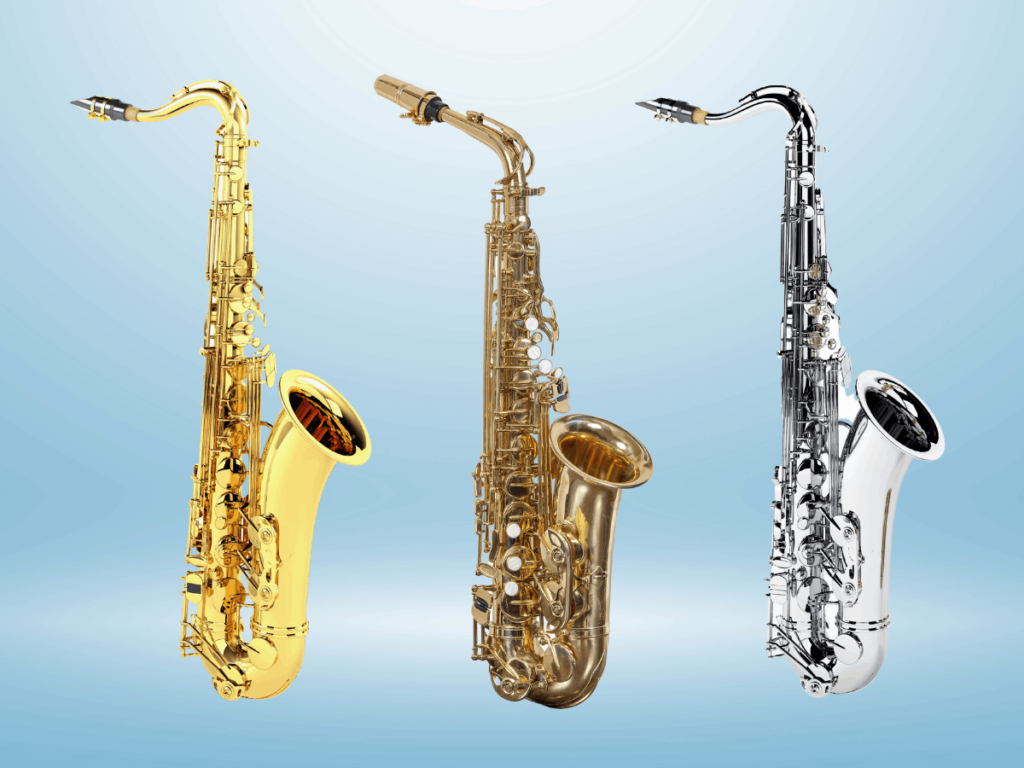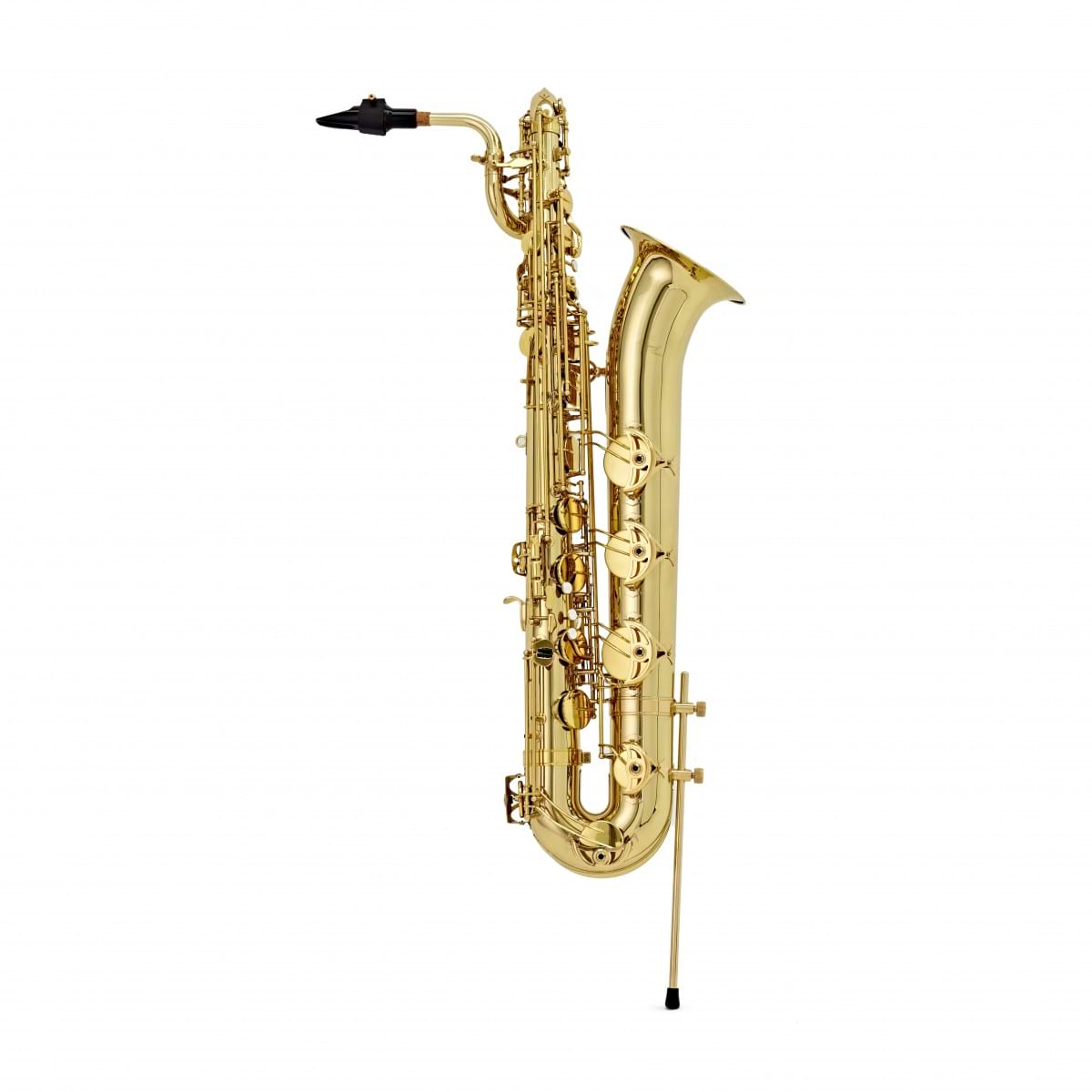Best
Alto Sax
for Beginners
-
Overall: Beautiful look and rich tone
-
Best Feature: Includes case & high-quality 4C mouthpiece
-
TedScore™: 9/10
Best
Student
Soprano Sax
-
Overall: A sophisticated and durable finish
-
Best Feature: Includes everything you need to get started
-
TedScore™: 9/10
Best
Beginner Tenor
Saxophone
-
Overall: Checked by UK technicians to ensure perfection
-
Best Feature: Yellow brass body for producing a versatile tone
-
TedScore™: 8.5/10
Do you ever catch yourself swaying to the smooth sounds of a saxophone and wondering, “Is saxophone woodwind or brass?” It’s a question as captivating as the instrument’s velvety melodies!
Created by the brilliant Adolphe Sax, the saxophone holds a place that might surprise you. With its shiny brass body, you might think it belongs to the brass family, but the saxophone has a woodwind secret.
I’ll reveal how the single reed tucked into its mouthpiece changes everything. So, keep on reading, and we’ll uncover this musical mystery together!
The Saxophone's Classification

In technical terms, the saxophone is classified as a woodwind instrument, even though it’s mostly made of brass. What defines a woodwind instrument is how it produces sound.
Woodwind instruments create sound by blowing air through a reed, causing it to vibrate and produce sound. This is precisely how the saxophone creates sound, making it a woodwind instrument.
Despite being a woodwind instrument, the saxophone shares similarities with brass instruments. For instance, it uses a brass mouthpiece, and sax players must use a similar embouchure technique for both saxophones and brass instruments.
The saxophone was originally designed to bridge the gap between woodwind and brass instruments. Adolphe Sax, the inventor, aimed to create an instrument that could deliver the power of brass instruments while maintaining the agility and flexibility of woodwind instruments.
The Construction of a Saxophone
When you picture a saxophone, you might think of a smooth, shiny metal instrument with a unique curved shape. But what’s inside this one-of-a-kind instrument?
A saxophone is a metal tube with a bell at the end. The tube is bent and curved in specific ways to give the saxophone its unique shape. The bell flares out to help the sound carry.

The mouthpiece is a crucial part of the saxophone. It’s the part that the player blows into and helps create sound.
The mouthpiece is made of hard rubber or metal and has a reed attached. The reed vibrates when the player blows into the mouthpiece, creating the saxophone’s sound.
The sound of a saxophone can be influenced by many things, like the size and shape of the instrument, the material it’s made from, and how the player uses it. Saxophones made from brass usually have a brighter, more focused sound, while those made from bronze or silver have a warmer, mellow tone.
Materials Used in Saxophone Manufacturing

The most common material used in making saxophones is brass, a mix of copper and zinc that’s easy to shape and resistant to rust, making it ideal for instruments exposed to air and moisture.
Some saxophones are gold-plated or silver-plated, but they’re still made of brass underneath. Gold plating can make the sound warmer and richer, while silver plating can make it brighter and more focused.
Materials like bronze, nickel, and zinc also create specific sounds or improve the saxophone’s tone. Lacquer is applied to protect the saxophone from moisture and give it a shiny or matte finish.
Lastly, bamboo makes the reeds for saxophones, producing a rich, warm sound when air is blown through it.
4 Main Types of Saxophones
The soprano saxophone is the smallest in the family and produces a high-pitched sound. It’s often used in classical music and jazz ensembles and a popular choice for soloists.
The alto saxophone is the most commonly played and is a great choice for beginners. It produces a smooth, mellow sound and is often used in pop and jazz music.
The tenor saxophone is slightly larger than the alto saxophone and produces a deeper sound . It’s often used in jazz music and is popular for soloists.
The baritone saxophone is the largest family member, producing a deep, rich sound. It’s often used in jazz and classical music and is popular for bass lines.
Recommended Saxophone for Beginners

DESIGNED FOR: An excellent choice for both beginner students and intermediate players
FEATURES: Easy blowing for perfect intonation
OTHER INFO: Comes with the popular 4C mouthpiece and ligature set that's easy to play with a quick response
Yamaha YAS280 Student Alto Saxophone
When you check the price above, you’ll see there are loads of great places to buy this item. Our personal favorite is Gear4music.
It is the largest music retailer in the UK and fast becoming the most respected online music shop in the US too. Their customer service is excellent, they have competitive prices, really fast shipping, and usually have the longest guarantee.
Most professional musicians use Gear4music, so there is no reason why you shouldn’t too!
- The carrying case is light but strong
- Includes everything you need, from a cleaning kit to cork grease
- Although this is a beginner model, the price is slightly higher than some other saxophones on the market. However, it will hold its resale value well
The professional musician who wrote this article combined many things,
from the product build, manufacturer’s reputation through to feedback
from other users, to create our famous TedScore™.

DESIGNED FOR: beginners who want the best model to start on
FEATURES: two options for the crook
OTHER INFO: makes it easy to get a good tone
Elkhart 100SS Student Soprano Saxophone
When you check the price above, you’ll see there are loads of great places to buy this item. Our personal favorite is Gear4music.
It is the largest music retailer in the UK and fast becoming the most respected online music shop in the US too. Their customer service is excellent, they have competitive prices, really fast shipping, and usually have the longest guarantee.
Most professional musicians use Gear4music, so there is no reason why you shouldn’t too!
- Comes with a mouthpiece and ligature
- Has a high F# key
- Good range
- Easy to play
- Uses a soft shell case
- Not the most affordable
The professional musician who wrote this article combined many things,
from the product build, manufacturer’s reputation through to feedback
from other users, to create our famous TedScore™.

DESIGNED FOR: beginners and students
COMES WITH: With rib-mounted keys for added strength to the keywork and improved resonance
OTHER: A robust and reliable tenor saxophone
Trevor James 'The Horn' Tenor Saxophone, Gold Lacquer
When you check the price above, you’ll see there are loads of great places to buy this item. Our personal favorite is Gear4music.
It is the largest music retailer in the UK and fast becoming the most respected online music shop in the US too. Their customer service is excellent, they have competitive prices, really fast shipping, and usually have the longest guarantee.
Most professional musicians use Gear4music, so there is no reason why you shouldn’t too!
- Checked by UK technicians to ensure perfection
- Includes a sturdy case, mouthpiece, and ligature
- The saxophone's finish may not be as good as on more expensive tenor saxophones
The professional musician who wrote this article combined many things,
from the product build, manufacturer’s reputation through to feedback
from other users, to create our famous TedScore™.

COMES WITH: protective case for storage and Basic accessories
FEATURES: constructed with high-quality materials, ensuring durability and a consistent tone
Odyssey Premiere Baritone Saxophone
When you check the price above, you’ll see there are loads of great places to buy this item. Our personal favorite is Gear4music.
It is the largest music retailer in the UK and fast becoming the most respected online music shop in the US too. Their customer service is excellent, they have competitive prices, really fast shipping, and usually have the longest guarantee.
Most professional musicians use Gear4music, so there is no reason why you shouldn’t too!
- Deep and rich sound adds depth and character to musical arrangements
- Can be used to play a variety of musical genres
- Built to last and can withstand the demands of frequent use
- High-quality baritone saxophone and is expensive
The professional musician who wrote this article combined many things,
from the product build, manufacturer’s reputation through to feedback
from other users, to create our famous TedScore™.
IS SAXOPHONE WOODWIND OR BRASS?
Summary
In the lively debate about whether the saxophone is a woodwind or brass instrument, it’s firmly placed in the woodwind family. Despite its shiny brass body, the method of sound production tucks it into the woodwind group, as sounds are made by blowing air across a single reed, similar to a clarinet or oboe.
Despite being made of brass, the saxophone’s use of a reed sets it apart. Unlike instruments like the trumpet and trombone, which belong to the brass family due to buzzing lips against a mouthpiece, the saxophone involves using a reed mounted on a mouthpiece, a classic woodwind technique.
Quick Nifty Breakdown:
- Material: Brass, but that’s not the deciding factor.
- Sound Production: Through a single-reed mouthpiece, like a clarinet or oboe.
So, there you have it! The saxophone may have the appearance of brass but sings with the soul of a woodwind. Its categorization isn’t idle talk; it reminds us that instruments, like people, are often full of surprises! Isn’t that wonderful?
Before you go…
Looking for the best saxophone reeds to take your playing to the next level? Look no further!
We’ve scoured the market to bring you the Best Saxophone Reeds to help you achieve your musical goals!
FAQ's
The saxophone is classified as a brass instrument because it is made of brass and uses a mouthpiece to produce sound. However, it is also considered a woodwind because it uses a reed to vibrate the air column inside the instrument.
Yes, the saxophone does have brass in its construction. The body and keywork of the saxophone are typically made of brass, which gives the instrument its characteristic sound and appearance.
The saxophone belongs to the woodwind family, specifically the single-reed woodwind family. It is a relatively young instrument, invented in the 1840s by Adolphe Sax, and has since become a staple in jazz, classical, and popular music.











hey i just read this thing about the soprano saxophone being small and good for solo stuff which is super cool cause i wanna start learning the sax and maybe do my own solos one day. but like, is it too hard for beginners? heard it can be kinda tricky and not sure if i should start with something like the alto or tenor instead? what do you guys think is the best for someone just starting out?
Interesting article, Hannah Haefele. However, considering the saxophone’s use of a single reed and its construction, would you not say it shares more characteristics with brass than woodwinds? I’ve always found this classification debate fascinating and would love to hear more thoughts on this.
always thought the sax was part of the brass fam because of its look lol good to know it’s woodwind
Really enjoyed the deep dive into the saxophone’s classification and construction, Hannah Haefele. It’s fascinating to see how materials play a crucial role in the sound and quality of the instrument. I’ve been teaching music for over a decade, and it’s articles like these that I find extremely valuable for my students. The section on the materials used in manufacturing offers great insight into why each saxophone sounds distinct. Keep up the good work!
Absolutely agree with you, Melvin. It’s essential for educators to have resources like this. Do you incorporate this material into your teaching curriculum?
nice one! got any tips on picking my first sax? keen to start but kinda lost lol